|
 Russula griseoviolacea Russula griseoviolacea
BiostatusPresent in region - Indigenous. Endemic
Images (click to enlarge)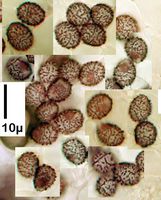
Owner: J.A. Cooper | 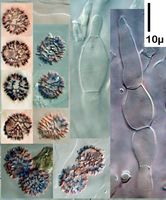
Caption: spores and pilocystidia (Melzers)
Owner: J.A. Cooper | 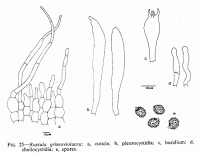 | 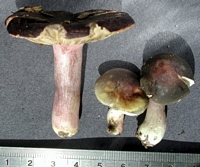
Caption: fruitbody
Owner: J.A. Cooper | 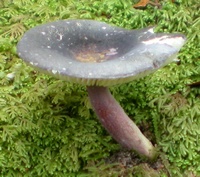
Owner: P. Leonard | 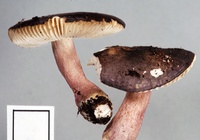
Owner: J.A. Cooper | 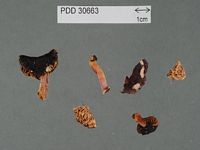
Caption: Dried type specimen
Owner: Herb PDD | 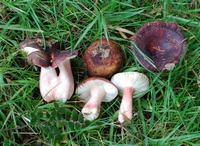
Owner: J.A. Cooper | 
Owner: J.A. Cooper | 
Caption: left: stem surface details. Right: lower right FeSO4, upper Guaiac.
Owner: J.A. Cooper | 
Caption: cap and gill details
Owner: J.A. Cooper |
Article: McNabb, R.F.R. (1973). Russulaceae of New Zealand. 2. Russula Pers. ex S.F. Gray. New Zealand Journal of Botany 11(4): 673-730 (http://www.rsnz.org/publish/abstracts.php).
Description: pileus: 2-5.5 cm diam., hemispherical to convex when young, centrally depressed at maturity,
slightly viscid under wet conditions, otherwise dry, finely subpruinose under
lens, velar remnants absent, deep greyish magenta to greyish violet, or dark
purple with vinaceous tints, sometimes dark grey to black and finely creviced
giving a sooty appearance, occasionally with greenish yellow areas: margins
entire, non-pectinate. Cuticle composed of thin-walled, or slightly thick-walled,
smooth or finely roughened, hyaline or yellow tinted, septate, hair-like hyphae
to 150 µm long, 3-5 µm diam., without coloured contents in KOH, terminal cells
unspecialised, tapering apically, originating from inflated, short-celled hyphae,
or occasionally from sphaerocysts: pilocystidia absent. lamellae: adnexed to adnate, crowded, thin, simple or occasionally forked
near stipe, to 4 mm deep, white to pallid creamy white, not discoloured at maturity,
lamellulae rare or absent. stipe: 1.5-4 cm long, ± equal or slightly expanded
basally, 0.4-1 cm diam., dry, solid, finely furfuraceous under lens, pallid
greyish magenta with rose tints, white flesh often showing through, occasionally
almost entirely white with faint rose tints basally; flesh white, unchanging
on exposure to air. Cuticle composed of interwoven, repent, thin-walled, septate
hyphae 2.5-5 µm diam., terminal cells projecting and aggregated into clumps;
caulocystidia absent. spores: spore
print not obtained; spores broadly elliptical to ovate, obliquely apiculate,
apiculus to 1.5-(2) µm long, 9.5-12 X 8.5-10.5 µm, ornamentation of dense, amyloid
or partially inamyloid, truncated spines to 1.4-(1.8) µm high, typically joined
basally by fine amyloid ridges and forming an incomplete reticulum, in small
confluent groups, or occasionally isolated; plage conspicuous. hymenium: basidia hyaline, clavate, 30-48 X 10.5-15
µm, 4-spored, sterigmata to 8 µm long; pleurocystidia scattered, rare to numerous,
broadly fusiform, hyaline, thin-walled, contents refractive in KOH, projecting
to 15 µm beyond basidia, apices acuminate, strangulate, or capitulate, 45-78
X 7.5-11 µm; cheilocystidia sparse, similar to pleurocystidia but shorter. hymenophoral
trama: heteromerous, intermixed. context of pileus: white, unchanging; structure heteromerous,
clamp connections absent. taste: lamellae and context mild. chemical characters: formalin on context—n.r.; phenol on context—slowly
deep vinaceous; FeSO4 on context—pallid salmon pink; guaiacol on stipe base—n.r.;
KOH on pileus—magenta colour disappears leaving area orange-red; on context—n.r.;
NH4OH on pileus and context—n.r.
Habitat: Solitary or gregarious under Nothofagus.
Notes: Microscopically R. griseoviolacea is
difficult to distinguish from R. roseostipitata; spore ornamentation
is rather sparser, and a partial reticulum often present. In macroscopic characters
it differs in FeSO4 reaction and in gill colour.
It can be classified in the section Rigidae
and possibly in the subsection Amoeninae in Singer's (1962) classification.
|